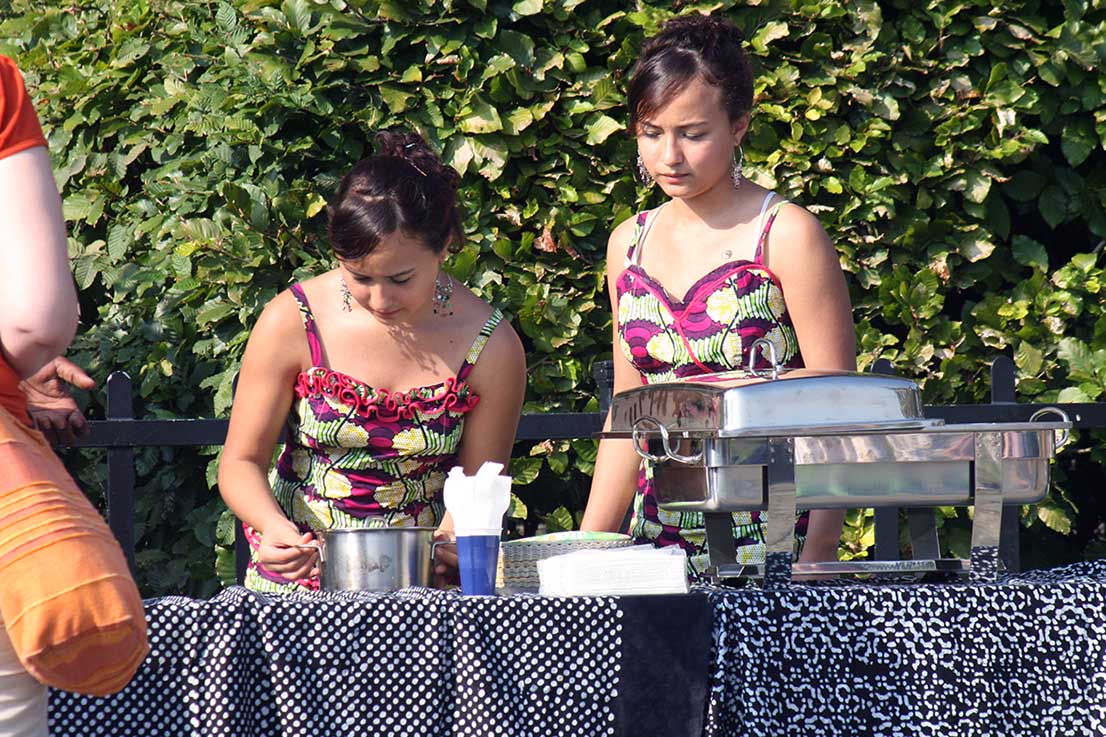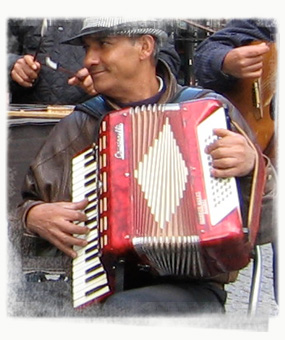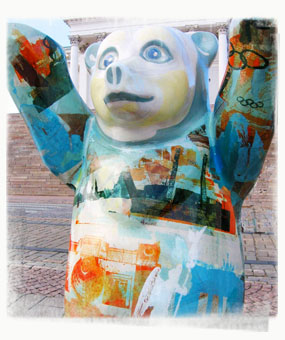The venue was so heavily 19th century European it seemed the most unlikely place to hold a celebration of the end of the Muslim month of Ramadan.
The Museuminsel was the former seat of Prussian might and comprised a palace (demolished in 1950), a cathedral and a museum. The latter two edifices, the Berliner Dom and Altes Museum, were monumental and loomed over an extensive formal garden called the Lustgarten (Pleasure Garden).
It was the garden that hosted the Familienfest zum Ende des Ramadans (The End of Ramadan Family Festival). In fact, throughout the fasting month, the garden and museum were venues for evening cultural events held after the breaking of fast. Ramadan ends with Eid al-Fitri in Arabic or Şeker Bayrami in Turkish or Zuckerfest in German.


As I walked towards the Lustgarten, the Familienfest looked overwhelmed by the colossal structures and decadent formalism.
But then, I was attracted to this celebration precisely because of that disjuncture. It seemed important that a non-German cultural/religious celebration be held far removed from its obvious abode such as Muslim-dominated Neukölln or Kreuzberg, where throngs of Turks and Arabs were likely to turn up, as for the community Maifest (Mayfest) event.
Still, I did wonder if the organisers, music and arts events organiser Piranha Kultur, had taken too big a gamble. But the devil, as they say, is in the details.
Walking past the Arabian nights story-telling tent, I spotted two colourfully dressed actors. They were playing the characters of Karagöz and Hacivat, originally traditional Turkish shadow-puppet characters.
The performance was on a bare platform littered with cushions beneath the Altes Museum’s massive Corinthian columns, making for a spellbinding sight and recalling its Ottoman roots and Greek theatre association.
By the time I reached the platform though, it had ended. I decided to wait for the next session.
As my eyes wandered over the crowd, I started seeing interesting images: striking twins in red and white dresses selling home-made food, a cute tot in a bright African batik outfit, a serious-looking blonde henna artist ..








Then the music started and the most fantastic sounds came from the stage to the left of the museum. I went over.
Senegalese Abdourahmane Diop commanded the stage with his motley, talented band who were playing saxophone, guitar, bass guitar, drums and what looked to me like a kora and djembe, respectively, a West African harp and drum.
Diop was a griot, a West African poet, praise singer, and wandering musician, considered a repository of oral tradition (Wikipedia), and his catchy music was infused with jazz, soul and funk.
He called on “all Muslim people, all Christian people” to be at peace: “We are all citizens of Switzerland!”
Soon, the Lustgarten was covered with bodies.
So that when the Orient Girls of the youth club Jugendclub Eastend Berlin started their belly-dancing performance in the middle of the green, they were surrounded by their audience. I positioned myself so that the amazing backdrop to the shimmying and flowing movements was that of the Berliner Dom.
My favourite dancer was a chubby teen with dyed hair and blue hennaed arms who expertly executed the hip lifts and shoulder accents.
The focus then shifted back to the stage, where talented home-grown acts Sefo and Cross Beatbox provided more great music with their hip-hop/RnB songs infused with Turkish and Arabic strains and beats.
I wandered over to the henna artist, attracted by a line of little girls waiting to be henna’ed. Some were poring over photo albums, immersed in the serious business of choosing the perfect design. They were waiting for a young man who was getting himself a scorpion motif which he had at first wanted drawn near his ankle but was dissuaded to do so by the artist.








Over at the Ramadan lantern making table, kids of various shades and stages of undress were colouring in ready-made patterns of lanterns and cutting them out. Children’s Ramadan lanterns are a very old Egyptian tradition and spectacular lantern illuminations characterise Cairo’s streets during the fasting month.
Meanwhile in the story-telling tent, squirming toddlers and older children were being entertained by tales from the One Thousand and One Nights and other folktales.
Outside the tent, I caught sight of organisers trying to pacify the grumpy-looking Karagöz and Hacivat. The actors were understandably upset as a repeat performance on the open-air stage was impossible in light of the blare of hip-hop from the stage.
Close by was the wife of either Karagöz or Hacivat, the only hijab-clad woman within kilometres.
Luckily, the story-telling ended and the Turkish actors were able to take over the tent. There, they found an appreciative and responsive audience. It was then that I realised that their version of this centuries-old Ottoman theatre was in German.








At the end, it was a lovely experience, though it lacked the numbers and community feeling of the Maifest.
And it definitely whetted my appetite for the concert the next night, which I thought would nicely round off my first Berlin Ramadan experience.
Dubbed Die Nacht Nach Ramadan (The Night After Ramadan), it was held at the Kulturbrauerei, an atmospheric former brewery turned performance venue. It looked very different from December when it was dressed in its Weinachtsmarkt finery.
The first set by Palestinian-French singer-poet Kamilya Jubran was decidedly eclectic. Singing in a contemporarised Arabic style, Jubran was very expressive, often scrunching up with emotion. According to the programme notes, an important motive in her work was about life in the diaspora.
But it was so experimental it was tiring and the multimedia text above her detracted rather than added to her performance, particularly since the English translation was so bad. Two English-speaking audience members in front of me were so turned off, they refused to clap at all.
In contrast, the second set was astoundingly beautiful.
I had never heard traditional Arabic maqam music before, what more experienced it live, and it was mesmerising, with tremendously varied melodies and rhythms and stirringly soulful singing.
The skillful and highly-trained classical duo Sidare astounded with not only voice but a range of drums and drumming and haunting strains from the djoze, a tiny stringed instrument that in turn sounded like a rebab, violin and banjo.
It seemed at times like jazz (indeed, improvisation is a characteristic of maqam), and reminded me variously of blue-grass, the Malaysian love ballad dondang sayang and Malay violin music.
What was more special was that the style performed that night was ancient and unique to Baghdad.
The evening ended with the Delta Ensemble, whose set comprised traditional Egyptian and Arab melodies on darbuka (drum), riq (tambourine), accordian, saxophone, oud and voice.
The Arabs (Egyptians?) in the audience were really appreciative of the music, clapping and bopping away. That stripped away the formality and infused the set with an infectious community feeling which got me head-nodding and foot-tapping as well.


Looking back, that first Berlin experience of Ramadan was really defined by performances and cultural activities. It is certainly very different from the way most Muslims in Berlin (and back in Malaysia) observe Ramadan and celebrate the end of it, which would be with prayer, food and communality.
But in a country where Islam is the largest minority religion but is little known and mistrusted, festivals such as these are key to bridging understanding. That year, it certainly did so by foregrounding events such as the Familienfest in a central historic location as the Lustgarten.
(In subsequent years though, the Familienfest was moved to Neukölln and other parts of the city. According to Piranha Kultur Director Anna Mechelhoff, the decision to do so was due to funding as well as an intention to expose different communities in different parts of town to the festival.)
I certainly went away with a greater appreciation of the breadth and beauty of music and cultural traditions of the Muslim world, as well as the intriguing ways in which they are being contemporarised and fused with German culture. ω


Die Nächte des Ramadan (The Nights of Ramadan) is organised annually by music and arts events organiser Piranha Kultur. The festival also includes tours of the Museum für Islamische Kunst (Museum for Islamic Arts), literature readings, films and discussions.
Check out the Youtube videos of performances by Abdourahme Diop, who passed away in 2012, Sefo and Cross Beatbox and the Sidare duo of Saad Thamir and Bassem Hawar.
Experienced: 09.09.2009 || Recounted: 11.11.2015
If you see this after your page is loaded completely, leafletJS files are missing.



